Measure
/in Uncategorized/door Joost HoogstrateADD_CONTENT_HERE
Startups Coming Together
/in Uncategorized/door Joost HoogstrateThis is a platform of various talented Individual who hold their hands together for helping their startups and willing to help us as well. People like rock stars scientists, and artists all completely based on their talents.
Our Companies are 360 degree diversified groups providing financial services social platforms, technologies health care and many more.
Fantasies of future inbox with powerinbox
/in Uncategorized/door Joost HoogstrateSince the Birth of email there is No Revelatory Change or new feature we have seen till yet. Powerinbox is the first step of looking towards the vision of 10 years in the future this was told by PowerInbox founder and CEO Matt Thazhmon however Email Will still have Reply, Reply All and Forward but what new you will notice might be a edit button and an app store button next to these buttons . They are working hard to make their Vision A realaity and The power inbox is the firstrong presence towards it.
These Application Will allow a end user to run applications inside Gmail hotmail or outlook the startup has raised $1.1 million in a funding round led by atlas ventures which was launches on Tuesday.
Power box will enable user to experience the liveliness of the inbox such as stock notification will come to life with power inbox what more when one when enjoy. A Facebook notification email displays photos, comments and Likes, and allows the user to comment from inside the message. A Twitter follower notification lets you follow back, tweet inside the message and view the person’s recent tweet.
The same user can manage Netflix movies Bidding on E bay Auctions Booking of flights and play games which is not possible now.
How Social Commerce Works The Social Psychology of Social Shopping
/in Social/door Joost HoogstrateAs a social psychologist, I’m interested in how social commerce works. Not for academic reasons, but for a purely practical reason. Understandingwhy it makes commercial sense to help people to connect where they buy and buy where they connect provides businesses with a strategic advantage; the opportunity to reap the rewards of a powerful insight-led social commerce strategy, as opposed to merely deploying social commerce as a set of tactical tools.
Jumping to the conclusion of a rather long post, I think that a psychologically informed understanding of how social commerce works points to the possibility of six particularly effective social commerce strategies.
But first the obvious. Social commerce makes commercial sense because it is good marketing, marketing with a big M that is, in the sense of Marketing as the business of solving people’s problems at a profit (as opposed to mere messaging). By providing online shoppers with useful tools to make better and more informed choices, social commerce helps shoppers do smart and savvy shopping. And in doing so, retailers can deliver expectation-beating shopper experiences that drive loyalty (purchase-repurchase) and advocacy (word of mouth).
The second more-or-less obvious reason why social commerce makes commercial sense is that social commerce allows brands and retailers to sell where customers spend their time; and today that means on social media platforms. Social commerce solutions are thus a cost-effective way to capture traffic and market reach. And if deployed smartly, they even raise the possibility of the impulse e-purchase, a huge and largely unplundered opportunity in e-commerce. For instance, it’s now possible to do virtual pop-up retail, throwing up campaign stores to accompany and monetize marketing campaigns.
But the third, and possibly most powerful reason why social commerce makes commercial sense is a little less self-evident; it’s based on the social psychology of social shopping. The takeout of what’s outlined below is that social shopping tools, when properly deployed, can harness the processes of social influence that take place when we’re shopping to improve propensity to purchase.
The Social Psychology of Social Shopping
At one level the social psychology of social shopping is easy; social shopping harnesses the human capacity for social learning, learning from the knowledge and experience of others we know and/or trust. This social learning faculty is part of our social intelligence, the ability to understand and learn from each other and profit from social situations. But social shopping tools also work at a more fundamental level, by playing to cognitive biases in how people are influenced by people when shopping.
In a nutshell, social psychology, the branch of psychology that deals with how people think about, influence, and relate to one another, has found that shoppers do what is popularly known as ‘thinslicing’ when they are out shopping. Thinslicing is a style of thinking (psychologists call it heuristic-thinking) that involves ignoring most of the information available, and instead using (slicing off) a few salient information cues, often social in nature, along with a set of simple, but usually smart mental rules of thumb (known as heuristics) to make intuitive decisions. Psychologists have identified six universal heuristics (mental rules of thumb) that shoppers use to process thinsliced information; social shopping tools are powerful because they harness these heuristics to make purchase decisions more likely. (Seehere and here for a quick overview).
Heuristic #1: Social Proof
The Rule: ‘Follow the Crowd’
How it Works: To resolve uncertainty of what to do or buy, we often look to what others are doing or have done, and take our cue from them. When something stands out as particularly popular or dominant, we instinctively perceive this as social proof that it is the correct, most valid option – it’s classic peer power in action.
The Classic Experiment: The 42nd Street Experiment (1969). A single passerby was asked to stop in 42nd Street NYC and gaze skyward for 60 seconds. Other passersbys walked past, ignoring him. But when15 passersby were asked to do the same thing, 40% of people on the busy street also stopped to look up, almost bringing 42nd Street to a complete a halt within a minute.
Classic Marketing Application: Using the ‘Power of Lists’ to associate a brand with the #1 spot ‘best selling’, ‘market leader’ ‘#1 choice’ or ‘fastest growing’.
Social Commerce Application: Social shopping tools that use social proof to stimulate heuristic-thinking shopping decisions include:
- Pick Lists such as wish-lists and gift-lists offer social proof about what people want and what is desirable
- Popularity Lists that allow shoppers to view options by ‘most popular’, ‘most viewed’, ‘most favourited’, ‘most commented’ etc provide social proof as to what’s best to buy
- Share-Your-Story tools for publishing customer testimonials provide social proof with a human-interest angle
- Social Media Reviews from other customers provide trustworthy social proof about product or service quality
- Social Recommender Systems tools provide social proof through personal recommendations derived from people with a similar profile
Social Commerce Examples: Pick Lists; Amazon, Best Buy, Kaboodle, StyleFeeder, ThisNext. Popularity Lists; Amazon, Apple (iTunes). Share-Your-Story; James Avery Jewellery. Social Media Reviews; Amazon, Apple, WineLibrary, Zappos. Social Recommender Systems; Netflix, Apple (Genius), Stylefeeder, Honk User Galleries, Burburry (in the trenches).
Heuristic #2: Authority
The Rule: ‘Follow the Authority’
How it Works: People have a natural tendency to defer to the conclusions of an expert or authority, regardless of what they say. With specialist knowledge, experience and expertise, they save us time and energy thinking things through.
The Classic Experiment: The Shockbox Experiments (1961). A majority (61-66%) of people recruited to participate in memory tests gave each other increasingly severe electric shocks up to and including a “fatal” 450V dose as part of the test, if asked to do so by an authority figure – a distinguished looking experimental scientist (participants receiving the shock were stooges, there was no real shock).
Classic Marketing Application: ‘Four out of five doctors recommend’ type supports in advertising (including using actors associated with authority roles, and putting actors in white coats to appear authoritative)
Social Commerce Application: Social shopping tools that use authority to stimulate heuristic-thinking shopping decisions include:
- Referral Programs stimulate recommendations from people in the know who shoppers trust
- Social Media Reviews by authoritative professional reviewers (blog reviews, webzine reviews, YouTube reviews), and also by existing customers because we assign authority to voice of experience
- Social Media Services that establish the retailer or brand as an authority
- User Forums are a source of authoritative information – the voice of community authority
Social Commerce Examples: Referral Programs; Amazon Affiliates, Gilt, VanRosen, Rue La La, Ideeli, Vente-Privée, Sky invite-a-friend. Social Media Reviews; Amazon, Apple, WineLibrary, Zappos. Social Media Services; Best Buy, Nike+. User Forums; Apple, eBay.
Heuristic #3: Scarcity
The Rule: ‘Scarce Stuff is Good Stuff’
How it Works: Our minds are hardwired to value scarce resources; we instinctively assign more value to opportunities as they become less available – part out of fear of potential loss (this is known as psychological reactance).
The Classic Experiment: The Cookie Jar Experiments (1975). Participants were asked to rate chocolate chip cookies. Experimenters put 10 cookies in one jar and two of the same cookies in another jar. The cookies from the two-cookie jar received far higher ratings, even though the cookies were exactly the same. (Also of note; ‘Romeo and Juliet Effect’ research that shows teen lovers who are restricted/prevented from seeing each other value their relationship more; and the Plexiglass Experiments that proves toddlers prefer toys that are made unavailable to them (by a plexiglass barrier)).
Classic Marketing Application: Limited access, limited offers, limited availability, limited editions, time-sensitive deals.
Social Commerce Application: Social shopping tools that use scarcity to stimulate heuristic-thinking shopping decisions include:
- Deal Directories that list exclusive time-sensitive shopping deals (often with a count-down clock), from those in the know
- Deal Feeds to get that exclusive deal the majority don’t know about
- Group-Buy tools that allow shoppers to be part of a great one-off deal
- News Feeds give get-it-first inside scoops to share and spread
- Referral Programs for private shopping events such as those on private shopping event portals
- Social Network Storefronts with great exclusive deals/products for social network members only
Social Commerce Examples: Deal Directories: Deals.Woot, JustBoughtIt, Ikea. Deal Feeds; Dell, Amazon, Carrefour. Group-Buy; Dell, Adidas, Groupon, Intel (FanPlan); News Feeds; Best Buy, NorthFace, Nokia (WoM World). Referral Programs; Amazon Affiliates, Gilt, VanRosen, Rue La La, Ideeli, Vente-Privée, Sky invite-a-friend. Social Network Storefronts; Best Buy, 1-800 Flowers, Reebok, Carrefour (FaceShopping).
Heuristic #4: Liking
The Rule: ‘Follow those You Like’
How it Works: We have a natural inclination to emulate and agree with people we like, admire or find attractive, partly because it builds social bonds and trust (saying yes is a form of social grooming – the human equivalent to animals picking fleas from each other), and partly because it’s part of impression management, managing our image and identity by association.
The Classic Experiment: Nixon/Kennedy Debate (1960). Radio listeners and television viewers were asked to rate the performance of two presidential candidates in a live broadcast debate. Radio listeners rated Nixon’s performance higher, but television viewers did the opposite – overwhelmingly handing the debate to Kennedy. The difference? Kennedy came across visually more likeable, more attractive and fresh-faced. Nixon, on the other hand was looking haggard (just coming from a hospital visit), unshaven and sweaty. (Also of note; research showing physical attractiveness (closely linked to liking) influences things as wide ranging as our salary and our likelihood to be found guilty in court (less attractive people twice as likely to be found guilty)).
Classic Marketing Application: Network marketing (Tupperware parties), likeable user-imagery in ads aspiration or similarity, selling with sex.
Social Commerce Application: Social shopping tools that use liking to stimulate heuristic-thinking shopping decisions include:
- Ask-Your-Network tools for realtime recommendations and opinions from shopper social circles (‘friendsourcing’)
- Deal Feeds to share and spread deals from brands shoppers like with people they like
- News Feeds to follow, share and spread social media news (on Twitter, YouTube, Facebook, RSS) about brands shoppers like with people they like
- Pick Lists such as those in social shopping portals for shoppers to follow and be followed by shoppers they like
- Referral Programs such as those on private shopping event portals that spread membership through affinity networks
- Share-With-Your-Network tools that allow shoppers to share shopping experiences/finds with their social circle (affinity network)
- Shop Together tools that allow shoppers to co-browse online stores together and get influenced by people they like
- Social Network Storefronts that allow shoppers to share and discuss shopping experiences with people they like within the safe walled garden of a social network
Social Commerce Examples: Ask-Your-Network: Charlotte Russe, Mattel, Jansport. Deal Feeds; Dell, Amazon, Carrefour. News Feeds; Best Buy, NorthFace, Nokia (WoM World). Pick Lists; Amazon, Best Buy, Kaboodle, StyleFeeder, ThisNext. Referral Programs; Amazon Affiliates, Gilt, VanRosen, Rue La La, Ideeli, Vente-Privée, Sky invite-a-friend. Share-With-Your-Network; Kaboodle, StyleFeeder. Shop Together; Charlotte Russe, Mattel, Jansport. Social Network Storefronts; Best Buy, 1-800 Flowers, Reebok, Carrefour.
Heuristic #5: Consistency
The Rule: ‘Be Consistent’
How it Works: When faced with uncertainty, we’ll opt for the one that is consistent with our beliefs and past behaviour. When our beliefs and behaviours don’t match up, we feel psychological discomfort, “cognitive dissonance”, which is a big motivator for trying to be consistent; particularly with any active, public and voluntary commitments we’ve made.
The Classic Experiment: The Big Billboard (1966). Experimenters, posing as members of the “Community Committee for Traffic Safety”, knocked on the doors of residents in an affluent residential area in Palo Alto, California, asking if they could put up a huge “Drive Carefully” billboard on their front lawn, completely obscuring their view. Not surprisingly, the vast majority (83%) refused outright, except for one group of residents, 76% of whom agreed. What this group had in common was that two weeks prior, they had been contacted and asked if they’d put a small “Be a Safe Driver” car sticker on their cars – virtually all had agreed. Once the residents had made a public commitment to a small request, they felt the need to be consistent with the large request, and accepted the big billboard.
Classic Marketing Application: Lifestyle ads (demonstrating why a product is consistent with audience lifestyle), free trials (become a user for free and stay consistent by buying later), sign up for free membership schemes, foot-in-the-door sales (ask for a small commitment (e.g. petition signing) then asking for a large commitment consistent with this (e.g. donation, purchase).
Social Commerce Application: Social shopping tools that use consistency to stimulate heuristic-thinking shopping decisions include:
- Ask-Your-Network tools involve a small public commitment to an item (asking friends about it) that is consistent with purchasing it later
- Social Gaming stimulates behavioural consistency between playing a branded game and later buying the branded product or service
- Pick Lists are the social shopping equivalent of petitions, small free public commitments to products consistent with subsequent purchases
- Share-With-Your-Network tools harness the consistency heuristic to drive loyalty and repurchase by creating publicly association between the shopper and purchased products and the e-commerce site
- Shop Together tools uses peer power to stimulate purchases by creating a social event around a store visit, that is consistent with purchasing
- Social Media Entertainment uses the small commitment of paying attention to make future purchases more consistent with past behaviour
- Social Media Listening uses the small commitment of providing ideas or feedback to make future purchases more consistent with past behaviour
- Social Media Reviews uses the small commitment of rating or reviewing to make future purchases more consistent with past behaviour
- Social Media Services uses the small commitment to a product or brand involved when using its services to make a purchase more consistent with behaviour
- User Forums allow shoppers to solve each others problems on behalf of the brand, a commitment that is consistent with purchase
- User Galleries create a public association and commitment to a brand, consistent with ongoing custom
Social Commerce Examples: Ask-Your-Network: Charlotte Russe, Mattel, Jansport. Social Gaming; Levi’s. Pick Lists; Amazon, Best Buy, Kaboodle, StyleFeeder, ThisNext. Share-With-Your-Network; Kaboodle, StyleFeeder. Shop Together; Charlotte Russe, Mattel, Jansport. Social Media Entertainment; Blendtec. Social Media Listening; Dell, Starbucks, Simple, eBay. Social Media Reviews; Amazon, Apple, WineLibrary, Zappos. Social Media Services; Best Buy, Nike+. Social Recommender Systems; Netflix, Apple (Genius), Stylefeeder, Honk. User Forums; Apple, eBay. User Galleries; Burburry.
Heuristic #6: Reciprocity
The Rule: ‘Repay Favours’
How it Works: We have a natural desire repay favours, whether those favours were invited or not. We feel good when we reciprocate favours, partly because of our innate sense of fairness and social contract, and partly because reciprocity is socially rewarded because it is the social glue that makes cooperation, relationships, community and society possible. Now you know why you feel bad when you receive a Seasons Greeting card from someone to whom you haven’t sent a card.
The Classic Experiment: The Coke & The Raffle Ticket (1971). Experimenters posing as art students joined group museum art tours and found they could sell significantly more student raffle tickets at the end of the tour to other members of the tour, if during the tour they did (unsolicited) favours to tour members – such as buying them a Coke. Tour members felt the need to reciprocate the favour, even though they had not asked for the Coke in the first place.
Classic Marketing Application: Sampling (reciprocating to uninvited gift with purchase), local CSR (corporate social responsibility) initiative, causal marketing and sponsorship. Door-in-the-face sales technique (making a big request upfront designed to be rejected, then making a concession, so shopper reciprocates and buys.
Social Commerce Application: Social shopping tools that use reciprocity to stimulate heuristic-thinking shopping decisions include:
- Deal Feeds that allow shoppers to do other shopper a favour by passing them on
- Group-Buy tools that allow friends to do their friends a favour and get them deals, which get reciprocated with participation
- Referral Programs that allow friends to offer exclusive access or special deals to their friends stimulate take-up and sales
- Social Media Listening tools that offer shopper a quid pro quo, we listen, you buy
- Social Media Services that are genuinely useful and that can be passed on
- User Forums that allow shoppers to offer each other buying/support advice – which through reciprocity translates to selling to each other
Social Commerce Examples: Deal Feeds; Dell, Amazon, Carrefour, Group-Buy; Dell, Adidas, Groupon, Intel (FanPlan), Referral Programs; Amazon Affiliates, Gilt, VanRosen, Rue La La, Ideeli, Vente-Privée, Sky. Social Media Entertainment; Blendtec. Social Media Listening; Dell, Starbucks, Simple, eBay. Social Media Services; Best Buy Nike+, User Forums; Apple, eBay
6 Social Commerce Strategies
The practical utility of looking at social commerce through the lens of social psychology is that is provides brands and retailers with a strategic approach to doing social commerce.
Rather than deploy social shopping tools based on a whims or sales pitches, the 6 social influence heuristics provide a framework for six distinct shopper-centric social commerce strategies, with their associated tools and which can be adopted and developed based on their fit with broader marketing strategies.
1. The Social Proof Strategy
2. The Authority Strategy
3. The Scarcity Strategy
4. The Liking Strategy
5. The Consistency Strategy
6. The Reciprocity Strategy
8 Ways to Discover Content Ideas From Your Readers
/in Social/door Joost Hoogstrate8 Ways to Discover Content Ideas From Your Readers
By Charlene Kingston
Published August 8, 2011 
 Are you looking for creative ways to discover what your readers’ interests are?
Are you looking for creative ways to discover what your readers’ interests are?
Imagine your online community is a group of hungry people who walk up to a table where you have a spread of finger foods and appetizers. That’s your online content.
By watching which items disappear quickly, you learn what your audience truly wants. That’s the content that satisfies their hunger. And that’s what you need to give them.
In this article I’ll show you 8 ways to discover what topics satisfy the hunger in your online community.
#1: Ask your community
Most businesses assume that they know what their online community wants to hear from them. There’s nothing like doing a reality check by asking your community directly. What you learn might surprise you.
Start by creating a list of 10 topics you believe your audience wants to hear. Use your list to create a survey and collect their opinions using one of these strategies:
- Ask them to say “yes” or “no” for each topic.
- Ask them to rank the topics in order of interest.
- Ask them to pick their 3 favorite topics.
Always include an option for “other” so they can fill in any topics that you didn’t include in your list. Pay careful attention to these topics. If someone goes to the trouble to write in a topic, it’s very important to him or her.
There are several popular services that allow you to create a free survey includingSurveyMonkey, Free Online Surveys, Zoomerang and Bzoink.
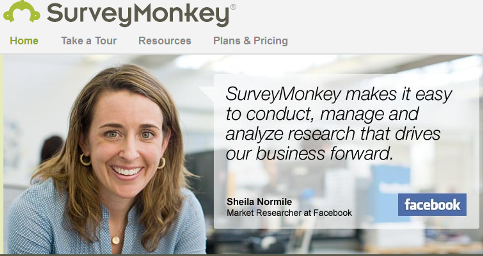 You can easily create smart professional surveys.
You can easily create smart professional surveys.You can add your survey to your website, highlight it in your email newsletter and promote it on Twitter and Facebook.
#2: Check your blog comments
Which blog posts get the most comments?
Most bloggers will tell you that their most popular blog posts often surprise them. It’s usually not the post that they like the best.
When you write a post that gets many comments, you know you have struck gold.Review the comments to see what about this post inspires your community.
- Are people interested in this topic? Write more blog posts about it. You might even create a new category for these posts to make them more visible to your visitors.
- Did people like the post format? Did you make a list? Did you review an article or a tool? If the format was a hit, then consider starting a series of similar posts. You can even make this a recurring feature on your blog.
Tip: If most of the comments on a blog post are questions, it means that your audience is looking for more information on this topic. You can become their go-to source by providing detailed answers to their questions.
#3: Check your retweets
You post things on Twitter that you believe are useful and interesting. However, value is always in the eyes of the reader. When your Twitter community loves the information in your tweet, they retweet it to their communities. Check for your most-loved tweets and turn them into important conversation topics.
The new Twitter makes it easy to find your retweeted items and how many people retweeted each one.
- Open Twitter.com and log in (if necessary).
- Click Home in the top menu (if necessary).
- Click the Retweets tab (in the left pane). Twitter displays the retweets menu.
 The Twitter Retweets menu options.
The Twitter Retweets menu options. - Select Your Tweets, retweeted. Twitter displays a list of your tweets that other people have retweeted in chronological order.
- Hover the pointer over the first tweet, and click the flyout button to see the retweet details.
 Click the flyout button to see the details about this tweet in the right pane.
Click the flyout button to see the details about this tweet in the right pane.Twitter displays the retweet details in the flyout (right pane).
- Locate the retweeter list for this tweet.
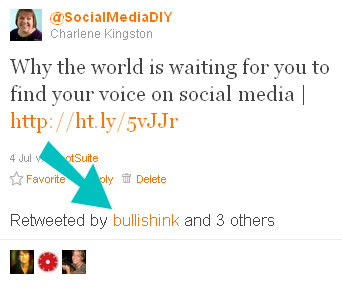 Twitter tells you how many people retweeted this tweet and displays their profile pictures.
Twitter tells you how many people retweeted this tweet and displays their profile pictures.
To analyze your retweets:
- Write down the number of retweets for each individual tweet in a month.
- Group together tweets into topics or categories.
- Add the individual retweet numbers to get a topic or category retweet total.
- List the 3 most popular topics based on retweets. Plan to talk more about these topics in the next month.
#4: Check your URL click-throughs
When you share a link on Twitter, you probably use a web address (URL) shortener to save space. Most of these services provide statistics about each shortened link. You can use these numbers to see which links people clicked most often. These are the topics that captured their interest.
The popular URL shortener services include Bit.ly, Goo.gl, Tiny URL, Cli.gs and Is.gd:
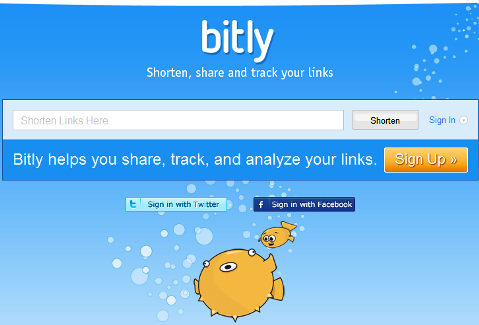 You can collect, organize, shorten and share links.
You can collect, organize, shorten and share links.HootSuite, the popular Twitter client (software that lets you use Twitter with additional features), provides two URL shorteners with statistics and detailed reports.
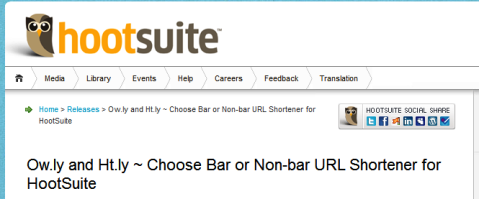 Users can now choose between two flavors of links—one with a social bar and one without.
Users can now choose between two flavors of links—one with a social bar and one without.The statistics on these services show you the number of times someone clicked through each link. Use this information to determine the most popular links. Group your links into topics or categories and get a total number of click-throughs by topic.
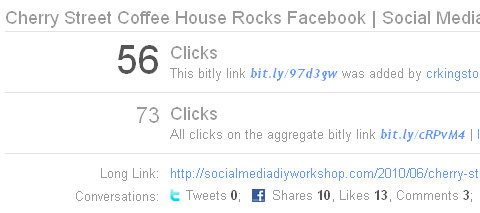 An example of Bit.ly statistics for a blog post about Cherry Street Coffee House.
An example of Bit.ly statistics for a blog post about Cherry Street Coffee House.Tip: Twitter.com uses its own shortening service, http://t.co, which doesn’t provide any statistics. You can use another service to shorten URLs before you paste them into Twitter if you want to get click statistics.
#5: Check your Facebook engagement
Facebook Insights provides details for page administrators about how users interact with their business page. It’s easy to see which status updates received the most feedback and interaction.
To display the interaction details for the previous month:
- Display your Facebook business page.
- Click View Insights (right column).
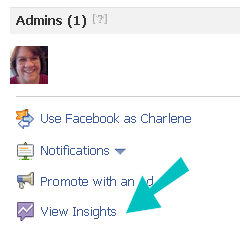 Click View Insights to display the page administrator’s statistics.
Click View Insights to display the page administrator’s statistics. - Locate the Interactions graph in the bottom half of the page.
- Click See Details.
#5: Check your Facebook engagement
Facebook Insights provides details for page administrators about how users interact with their business page. It’s easy to see which status updates received the most feedback and interaction.
To display the interaction details for the previous month:
- Display your Facebook business page.
- Click View Insights (right column).
 Click View Insights to display the page administrator’s statistics.
Click View Insights to display the page administrator’s statistics. - Locate the Interactions graph in the bottom half of the page.
- Click See Details.
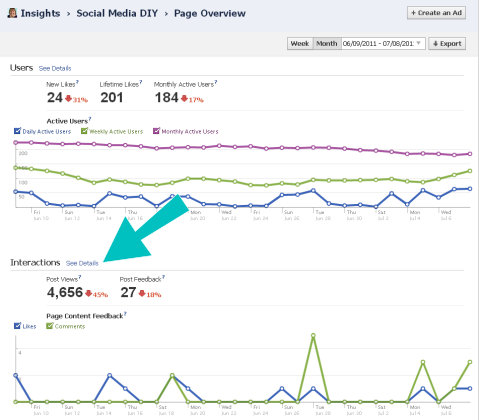
Facebook displays the interaction details for the previous month.
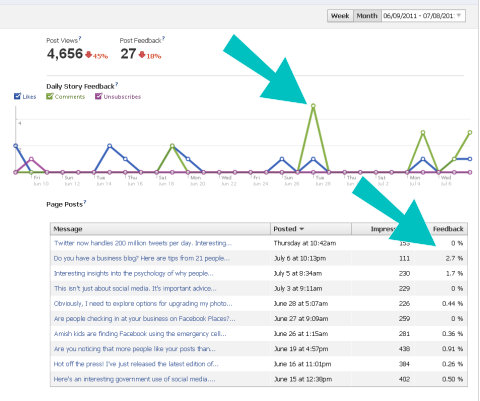 The chart provides detailed information about your status updates and how your community interacted with each one.
The chart provides detailed information about your status updates and how your community interacted with each one.Use the detailed information to find the popularity of each status update.
- The top graph provides the total count of likes and comments for each day of the month.
- The middle chart provides details about individual posts. Click on the column headings to sort the data by column.
Group your status updates into topics or categories. Talk more about the topics that get the most likes and comments.
#6: Ask Facebook questions
The Facebook Questions feature makes it easy for you to ask questions to anyone in your online community.
Before you start, write out your question with multiple-choice answers. Each community member must choose one answer to your question.
- Display your Facebook business page.
- Click Question.
 Click Question to start creating your Facebook Question post.
Click Question to start creating your Facebook Question post. - Facebook displays a blank question form.
 The Facebook Question form before you type any information.
The Facebook Question form before you type any information. - Type your question.
- Click Add Poll Options.
 The Facebook Question form before you add the poll options.
The Facebook Question form before you add the poll options.Facebook adds blank poll options to the question form.
- Type each multiple-choice option to answer your question. Facebook automatically adds blank options as you type.
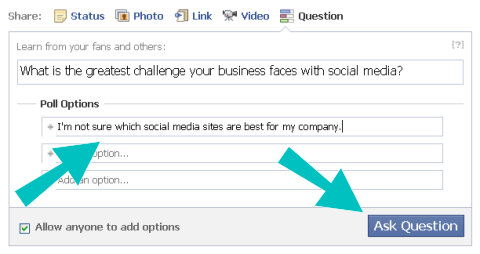 Complete the question options and click Ask Question.
Complete the question options and click Ask Question.Tip: Leave the check for “Allow anyone to add options” so your community can add options you did not consider.
- Click Ask Question. Facebook posts your question on your wall and distributes it to the news feed of people who like your page.
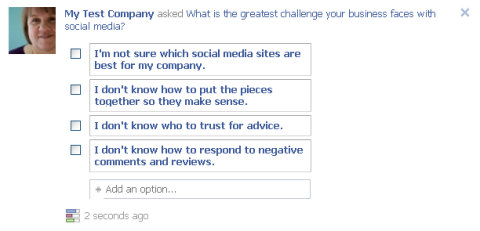 An example Facebook question on a business page wall.
An example Facebook question on a business page wall.
#7: Check Twitter favorites
Twitter’s Favorites feature lets you mark a tweet in your timeline that you like or want to be able to find again.
You can use Favstar to find which of your tweets people have marked as favorites. This gives you insight into which topics resonate with the people who follow you.
To review your tweets marked as favorites by other people:
- Display Favstar.fm.
- Click Sign In With Twitter.
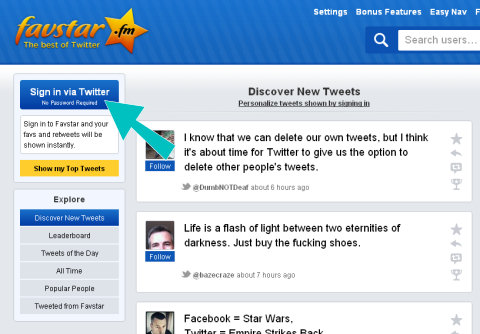 The Favstar front page before you sign in.
The Favstar front page before you sign in.Favstar displays the Twitter sign-in page.
- Click Sign in Now.
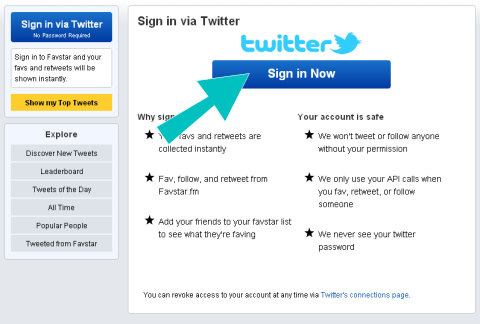 Twitter requires you to sign in and authorize Favstar before Favstar can find your tweets marked as favorites.
Twitter requires you to sign in and authorize Favstar before Favstar can find your tweets marked as favorites.Favstar takes you to Twitter.com.
- Click Authorize app.
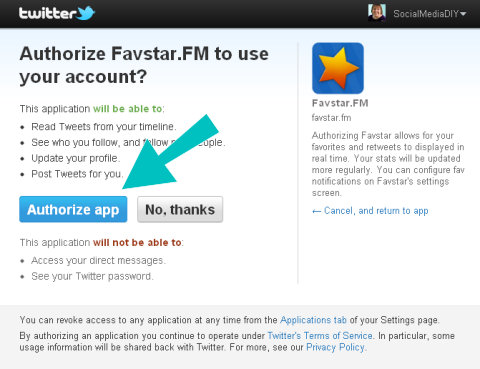 Twitter explains what Favstar can and cannot do after you authorize it for your account.
Twitter explains what Favstar can and cannot do after you authorize it for your account.Twitter authorizes Favstar to look for people who marked your tweets as favorites and displays your customized Favstar page.
- Click My Tweets.
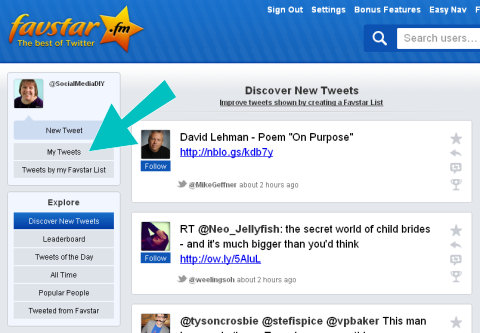 Click on the My Tweets button here.
Click on the My Tweets button here.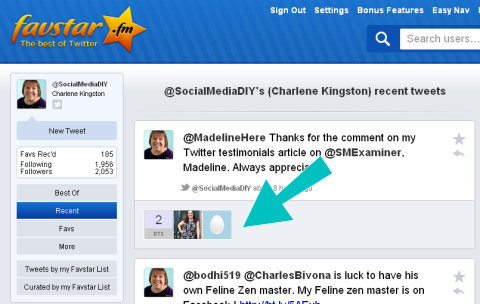 Favstar displays your tweets marked as favorites with the most recent on top.
Favstar displays your tweets marked as favorites with the most recent on top.
Scroll through your most recent tweets. Group them into topics or categories.Calculate a total favorite count for each category. Talk more about the topics that get the most favorites.
#8: Check your email newsletter click-throughs
If your business has an email newsletter, it’s another great resource for tapping into what people really want to hear from you.
There are many useful email services such as AWeber, Constant Contact and Mail Chimp. While they offer slightly different services, they all let you track the clicks from your newsletter to your website or blog.
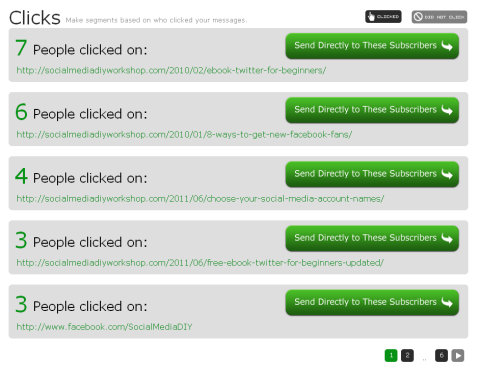 An example report from AWeber showing the links clicked in an email newsletter.
An example report from AWeber showing the links clicked in an email newsletter.
Reviewing the most clicked-through links gives you insight into what people found the most interesting in your newsletter. Talk more about the topics represented by your most popular links.
5 Big Mistakes To Avoid in Your QR Code Marketing Campaign
/in SEO/door Joost HoogstrateMatthias Galica is CEO of ShareSquare, the leading platform for connecting offline audiences to the brands they love via QR codes and custom HTML5 mobile web apps with real-time analytics.
Consumer-facing QR codes are hitting mainstream America hard this summer. Despite the idea that a rising tide lifts all boats, many well-intentioned marketers are crippling their campaigns with simple mistakes.
This is a big reason why QR codes still get a bad rap from some folks. QR codes by themselves are fundamentally neither good nor bad, they’re just a means to an end: an offline-to-online delivery mechanism. It’s what’s beyond the code that usually determines whether the experience will delight or disappoint.
Unfortunately, many early adopter marketers aren’t yet fully versed in the best practices or optimal use cases. It’s the adventurous consumer that suffers from the growing pains.
Since I’ve spent the past 18 months waist-deep in this fast-developing market, I’m compelled to offer up my short list of basic mistakes to avoid at all costs. While heeding all these rules won’t make your QR code marketing great by itself, they will likely save you from some embarrassment.
Mistake 1: Not Testing the Code
 Common sense right? Until you’re able to read a QR code just by looking at it, you should always test the proofs with a variety of smartphones and scanning apps before you release a campaign.
Common sense right? Until you’re able to read a QR code just by looking at it, you should always test the proofs with a variety of smartphones and scanning apps before you release a campaign.
This is the simplest way to spot scanning problems. For instance, a small placement (less than an inch) will often be too dense to scan if you’ve encoded a longer URL, but using bit.ly or goo.gl to automatically generate a short URL QR code is an easy fix.
Since QR codes feature up to a 30% error correction rate, there’s flexibility for creative branding and tweaks. But if the designer accidentally overdid it, test-scanning is an easy path to being the office hero that day.
For example, the above image is taken from “15 Beautiful and Creative QR codes.” While visually interesting, I’m fairly confident this isn’t scanable.
Mistake 2: Getting Too Fancy With Text

If your goal is to get people to a mobile web experience, you should only ever encode a short URL. Don’t include any plain text, since many barcode scanners (even gold standards like ShopSavvy) won’t tease out the link. If you’re hoping a user will copy/paste on a mobile device, don’t bet on it.
Think of the QR code as a physical hyperlink that every barcode scanner should be able to immediately “click.” If your QR code requires the user to do much more than point and scan to arrive at the intended content, you’re probably doing it wrong.
Take the image above. I love the Olsen twins as much as the next guy, but these QR codes result in the oft-problematic text string + link combo. Fail bonus: The site consistently turns up invalid security certificate errors.
Mistake 3: Serving up Non-Mobile Pages
 Your QR code scans successfully but you’ve pointed the user to a standard desktop website, when 99.9% of QR codes are scanned by a mobile device. Fail.
Your QR code scans successfully but you’ve pointed the user to a standard desktop website, when 99.9% of QR codes are scanned by a mobile device. Fail.
Get acquainted with HTML5 to give your mobile web app that native app feel. You can either hire a developer to build your mobile site or use a non-technical modular CMS (content management system) like Paperlinks if it suits your campaign objectives.
This Coca-Cola QR code’s heart is in the right place (the MyCokeRewards program) but the resulting non-mobile website is all but impossible to navigate.
Mistake 4: Putting QR Codes Where There’s No Data Signal

Where your ad will run is just as important as how you implement it.
Tesco’s recent QR code “grocery store” in a Korean subway worked great because those platforms have Wi-Fi. This is not the case in the U.S. Placing QR codes in locations without Internet access is a sure way to make your audience upset. Make sure you know where the ads will be, and if possible, run tests to make sure they are visible and will still work.
For example, the Red Bull campaign QR code above was in a New York City subway, so I have no idea what it does.
Mistake 5: Not Offering Enough Value

This point is highly subjective but also probably the most important. The proper mindset is to reward the user for scanning your QR code. This “reward,” however, will change depending on what you’re trying to promote.
Try to avoid redundancy (a digital copy of your flyer), irrelevance or dullness (your company’s street address). Take the above image. The U.S. Marine Corps. QR code promises a cool experience but instead leads to a wallpaper download and a commercial.
When coupled with a clearly articulated call-to-action near the QR code, we’ve found the most compelling campaigns tend to offer one or more of the following:
- Exclusive rich media, videos and photos
- Exclusive or time-sensitive access
- Free downloads or swag
- “Instant Win” contests
- Special offers, coupons or gifts
- “Secret” information
- Deep integration with social media to activate viral loops
The best advice is to put yourself in the shoes of your target fan. Would you bother pulling out the phone for your campaign? Would you be happy with the pay off? A little bit of time and thought can create a truly successful QR campaign.
How To Tag A Magazine Reader
/in Interaction design/door Joost HoogstrateTaking things one step further than ordinary QR codes, or even slightly enhanced QR codes, marketing technology company SpyderLynk used the September issue of Glamour to debut Social SnapTags.
Social SnapTags are placed throughout magazines, on both editorial and advertising pages, and for the Glamour issue, readers with iPhone or Android devices can install the magazine’s Friends and Fans app to like or follow the Facebook or Twitter accounts of featured brands, while those with other camera phones can send a picture to a designated short code for the same results.
The cover of the September edition of Glamour features a Social SnapTag that leads users to exclusive content from the cover subject of the month, Rihanna.
Other SnapTags within the issue allow users to follow editors on Twitter, access exclusive celebrity chats and behind-the-scenes videos on the magazine’s Facebook page, and take advantage of deals including discounts, gift cards, trips to New York, coupons, free overnight shipping, and the chance to win a kitchen makeover.
Brand offers can also be shared with Facebook friends and Twitter contacts directly via Social SnapTags.
SpyderLynk Chief Executive Officer Nicole Skogg said in a press release:
Social SnapTags allow marketers to leverage their mass marketing to drive connections with socially active consumers. With the marriage of SnapTags and social media networks, brands are now more equipped than ever to engage and build sustainable relationships with consumers.
And Glamour Executive Creative Services Director Jenny Bowman added:
By incorporating Social SnapTags into Glamour‘s new Friends and Fans app, we were able to give both our advertisers and readers immediate gratification and a smart way to connect brands to all their key social networking sites. What’s not to like?
Readers, have you ever followed a QR code to get to a website? And would you use technology like Social SnapTags to delve further into advertisements in magazines?
Advertise On Facebook
/in Usability/door Joost HoogstrateAdvertisers wishing to target Facebook members in specific zip codes can now do so. The social network has made the new targeting option available to advertisers via Facebook’s Power Editor and Ads Manager self-service tools.
Facebook has confirmed that zip code targeting, which was spottedby Politico, is now available in the U.S.
“The zip code targeting launched yesterday and this change was made due to requests for such a change,” a Facebook spokesperson tells Mashable.
Advertisers, previously able to target members by country, state or province, can now direct ads and sponsored stories to users in more localized areas.
“Over the past few months Facebook has been showing sidebar modules asking users to confirm which of several zip codes they are closest to or live within,” Inside Facebook reports.
Now that advertisers have the potential to reach hyper-local audiences, what types of ads should Facebook users expect? Local merchants and small businesses are the most likely candidates to promote products and services by zip codes. Politico also theorizes that the addition of zip code targeting will factor into upcoming elections.
“In an election cycle when social networking is expected to play such a big role, Facebook’s new program signals its intention to be a major player in the sprawling, and lucrative, market of local campaigns,” the site contends.
Email marketers And Opta
/in E-Mail/door Joost HoogstrateOpta the end of May 660,000 euro fines handed out in the e-mail marketing industry.Dialogue as a marketer I am also rather not too busy with legal matters, but these fines are enough reason to explore what’s really going on.
In particular, the notion of co-registration is disputed. This is a time of asking permission to obtain the e-mail address for multiple titles, brands or companies. According to the Opta can not. How about this?
Back to the basic
purpose of the Telecommunications Act is to protect consumers. With e-mail marketing is the protection against unsolicited email or spam. The consumer must give permission to be mailed. There must also question of what the industry informed consent is called. The recipient of the e-mail must be informed about the purposes for which the advertiser email address used.
Obtain permission by title or brand
‘s recent strict interpretation of the Opta about co-registration implies that companies with multiple brands carry a title or title / brand must obtain permission. In many cases, recipients of e-mail now have permission to e-mail received from:
- The title or brand, such as leaves or brand Conimex Farm
- The company or group (and the other titles or brands within the group). In this example, Unilever and Reed Business
- Relevant offers from third parties
In interpreting the Opta option 2 and option 3 is impossible. Even if people here have given permission for it.
The current situation and the consumer
in most list brokers and offers advertisers the permission obtained from third parties, so good.You often see texts in the email as “You are receiving this email because you registered with XYZ”. Recipients e-mail to unsubscribe from these e-mailings and thus receive nothing.
However, it can go wrong with some lead generators. Lead Generators recruit many email addresses (leads) with online games and contests. For example, “Join and win an iPhone XXX”. The terms and / or privacy statement of any part of this branch is an almost unlimited freedom stipulated for various commercial activities with the e-mail address is not defined third parties. The question is whether the requirement of informed consent are met. Is it clear enough what consumers can expect? Opta does not think so.
The problem is often for the launch for some mailing lists. After registration an e-mail address in an online game, a game organizer ten such party the right to exploit this email address.One party sends an e-mail and write the consumer himself. Assuming that the enrollment is processed through a good party, that party will no longer be accessed. But still by the parties two to ten.
Informed or not?
Opta states that in a situation as in the example above, the consumer registration information is insufficient. In the case above, I can sympathize with this view. But is the recipient of e-mail in all cases of co-registration were not sufficiently informed? Because there are numerous other situations where it refers to ‘informed consent’.
In the aforementioned examples such as Unilever and Reed Business, the recipients of the email very easy to find out what titles or marks of the companies have stopped feeding. A visit to the home page is often sufficient. That seems to me clear. Some collectors call addresses to obtain the email address of the advertisers they work with. It is also clear to the consumer.
If a consumer gives permission for third party offers, is to show that he was confident that the party to whom he authorizes to make a good assessment of what is relevant. If that trust is not there, he does not need to do to win iPhone. A consumer must of course be aware that others may be given e-mail.
Nuance lacking in the OPTA, indicating that all co-registration in violation of the law mentioned in the introduction, in particular the requirement for informed consent.
What do the experts
in this field phone inquiries of specialist lawyers Alexander Singewald, Jette Sprey and Christiaan Alberdingk Thijm Opta shows that there is a lot to the experts after strict interpretation holds. They consider it unlikely that the privacy of the e-mail recipient is struck so that the rigid position of the Opta justifies.
Simple solution
in my eyes is a simple solution:
- Be transparent. Suppose it mandatory that the unlimited possibility to use the e-mail address is not in the privacy statement or the conditions are hidden. And more importantly;
- Make sure the receiver is given permission by user, but all at once at the source can withdraw. Where the source of the lead generator / organization that has collected the address. If a consumer can unsubscribe at source for all commercial use of the e-mail, there’s nothing (more) going on.
This will help us reduce impact on the industry, co-registration remains possible. The recipient of the e-mails will be better and may, if he wishes, for all e-mails at once unsubscribe.
The companies have been fined and will object if necessary. on appeal. That is take some time, if any case is expected in early 2012.
Over ons
E-commercemanagers.com heeft als missie om bedrijven en organisaties succesvoller te laten zijn in het digitaal geautomatiseerde tijdperk.
Wij geloven dat analyse en inzicht in de oorzaken van vraagstukken cruciaal zijn vervolgens oplossingen te implementeren die efficient, effectief en schaalbaar zijn.
Data, automatisering en personalisatie hebben daar in de meeste gevallen een belangrijke rol in.
Wij werken op een agile wijze met scrum technieken en proberen snel tot de kern te komen.
Inschrijven nieuwsbrief
Schrijf u nu in voor de maandelijkse nieuwsbrief:
Laatste nieuws
- European Accessibility Act (EAA) 20 april 2024
- SEO: het einde is nabij door SGE 20 april 2024
- GA4 calculated metrics 14 december 2023
- Google Analytics 4 blogs 19 augustus 2023
- Vijf no-code automatiseringsplatformen voor data en procesintegraties 15 juli 2023
Algemeen
Contactgegevens
E-commercemanagers.com
⛾ Goudenregen 12
8141 XA HEINO
☎ 038-2340222
✉ info [at] e-commercemanagers.com
